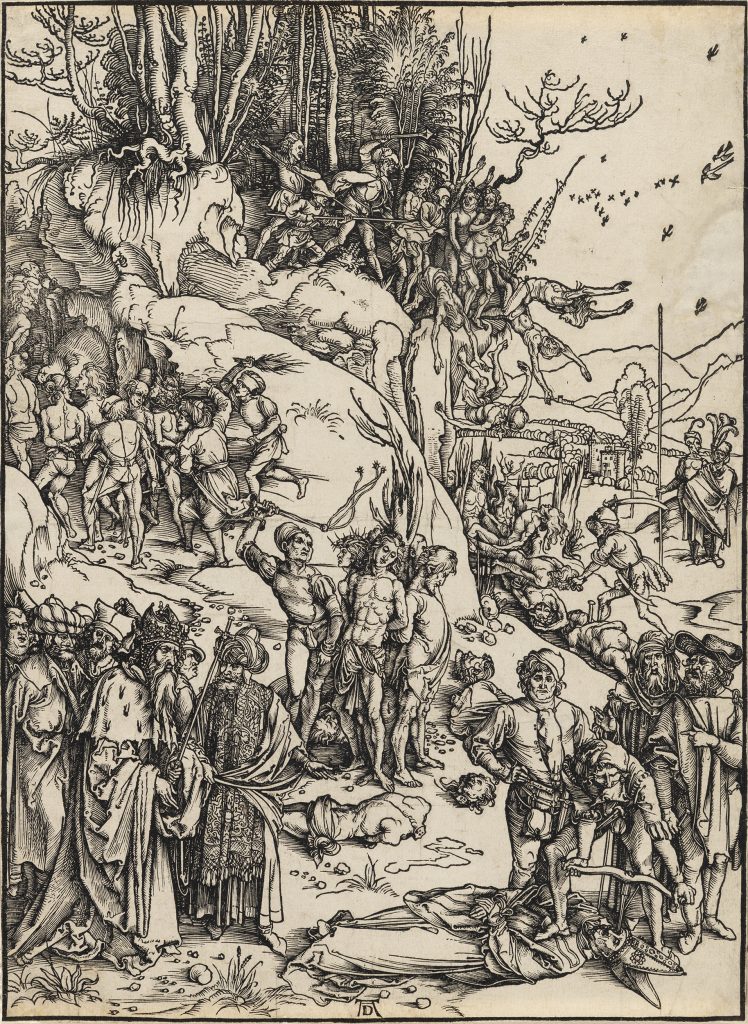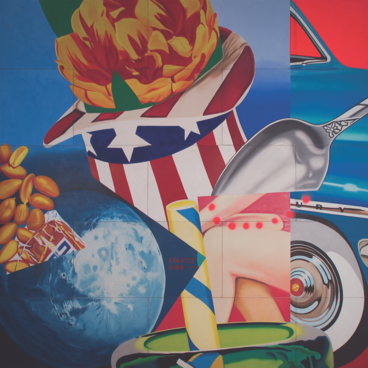Severed heads roll on the ground, whips swirl through the air, men are forced off a cliff, and a bishop’s eye is gouged with a hand crank, right at the feet of a group of richly dressed noblemen. Albrecht Dürer’s The Martyrdom of the Ten Thousand revels in displaying brutal methods of torture and execution. In this woodcut, Dürer portrays a popular medieval legend, telling the story of ten thousand Roman soldiers who converted to Christianity. It was illegal to refuse to sacrifice to the Roman gods, and the mass conversion angered the emperor, who ordered the king of Persia to execute the converts. The Persian king stands at the bottom left of the piece, overseeing the torture of Saint Acacius, who had encouraged the soldiers to convert.

Albrecht Dürer worked in Germany in the late fifteenth and early sixteenth centuries, and he is widely considered the greatest printmaker of the Renaissance. To create this image, Dürer used a technique called woodcut printing. He carved his design into a block of wood and then covered it with ink, making a kind of stamp that could be pressed onto paper. Since the ink touched only the raised part of the block that hadn’t been carved, Dürer had to work in reverse, removing the areas of the block that he didn’t want to appear as black on the print.
The woodblock that Dürer used to make this print survived through the centuries, and today is in the British Museum. This made dating the print a challenge, since it could have been created any time after Dürer carved the block. However, the paper the image was printed on hints at the age of the work. Before the mechanization of papermaking in the nineteenth century, paper was made by spreading pulp evenly across a wire sieve. Excess water drained between the wires as the sheet of paper dried, leaving a pattern of parallel lines that can be seen when the paper is held up to light. WAM’s print of The Martyrdom of the Ten Thousand was made on this type of paper, known as laid paper, pointing to an early date of printing.
A watermark visible on the paper confirms an early date for the work, suggesting it was made during Dürer’s lifetime. Watermarks were made by placing a wire design on the sieve during the papermaking process, leaving a mark on the page. A watermark of an orb with a cross through it appears centered on the severed head at the bottom of the work. By comparing this watermark with those on other editions of this print, especially the one in Australia’s National Gallery of Victoria, we can be confident that this print was made on paper from the early sixteenth century.
Eventually this Renaissance print made its way from Europe to the United States, where it was sold, surprisingly, in a Sears catalog. Between 1962 and 1971 Sears offered original works of fine art for sale through its Vincent Price Collection, all priced below a few thousand dollars. Best known for his long film career and his voiceover in Michael Jackson’s Thriller music video, Vincent Price was also an art collector and connoisseur, having studied art history at Yale. He had complete control over the collection for sale at Sears, and he acquired works by famous artists such as Picasso, Whistler, Rembrandt, and Salvador Dalí. Price was the face of the brand, and he was passionate about increasing the appreciation and ownership of art. The program was a success, and Sears achieved its goal of making fine art available to middle class Americans, selling more than 50,000 works through the Vincent Price Collection.
From a woodblock carved by Albrecht Dürer, printed on laid paper in Germany over 500 years ago, to a collection curated by Vincent Price and sold at Sears, the medieval legend The Martyrdom of the Ten Thousand was recently accessioned and will now be on view at WAM.


